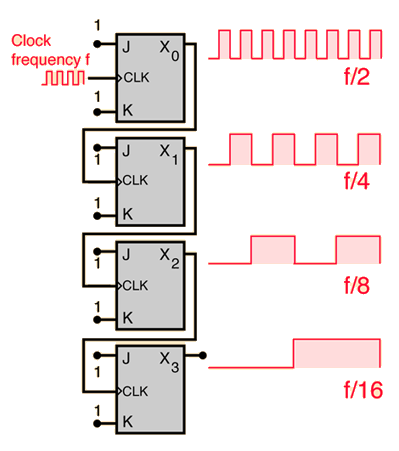Frequency Division and Counting
Frequency Division
In the tutorials, we saw how D-type Flip-Flop´s work and how they can be connected together to form a data latch . Another useful feature of the D-type Flip-Flop is as a binary divider, for Frequency Division or as a “divide-by-2″ counter.
Divide by 2 counter
It can be seen from the frequency waveforms above, that by “feeding back” the output from Q to the input terminal D, the output pulses at Q have a frequency that are exactly one half ( f ÷ 2 ) that of the input clock frequency. In other words the circuit produces Frequency Division as it now divides the input frequency by a factor of two (an octave).This then produces a type of counter called a “ripple counter” and in ripple counters, the clock pulse triggers the first flip-flop whose output triggers the second flip-flop, which in turn triggers the third flip-flop and so on through the chain producing a ripple effect (hence their name) of the timing signal as it passes through the chain.
Frequency Division. The Q output of the second flip-flop is one-fourth the frequency of the original clock input.
 Frequency Division
Frequency Division
To enable local scheduling with channel state information for wireless multi-hop networks with orthogonal frequency division multiplexing (
Frequency Division Summary
For frequency division, toggle mode flip-flops are used in a chain as a divide by two counter.
The final output clock signal will have a frequency value equal to the input clock frequency divided by the MOD number of the counter. Such circuits are known as “divide-by-n” counters. Counters can be formed by connecting individual flip-flops together and are classified according to the way they are clocked.
Frequency Counting
| CB FREQUENCY COUNTER |
The basic idea of making a frequency counter is to count the number of cycles of the input in one second. We can keep one counter that keeps counting the rising/falling edges of the input signal. Then we can read the value of this counter once in a second and then clear it. The value we read from the counter is nothin but the frequency of the input signal.
The reciprocal method seems to also be impmemented to cheap frequency counter because of price of microcontrollers falls.
The hi-tech frequency counter board

Frequency counter counting

This is one of the frequency measureing methods that was thought out to make up the defect of direct counting method, and it is prevailing now. This method measures the period (T) of the input signal instead of number of cycles, and calcurate its frequency in the formula f = 1 / T with a microprocessor. Its frequency resolution depends on only time resolution independent of the input frequency.




Tidak ada komentar:
Posting Komentar